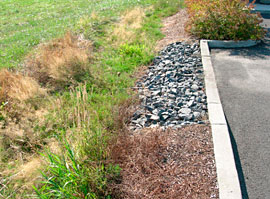Filter Strip
A filter strip is a straight swatch of grass that removes sediment and oils from stormwater. Usually, filter strips are along edges of paved areas such as parking lots and roads.
Maintenance is needed if you see these signs
Bare, exposed soil
Clogged inlet and outlet pipes
Bottom of swale is eroded
Sediment buildup, usually near inlet
Unhealthy or dead vegetation
Blackberries or other problem vegetation
Overgrown vegetation
Leaves, trash and other debris
